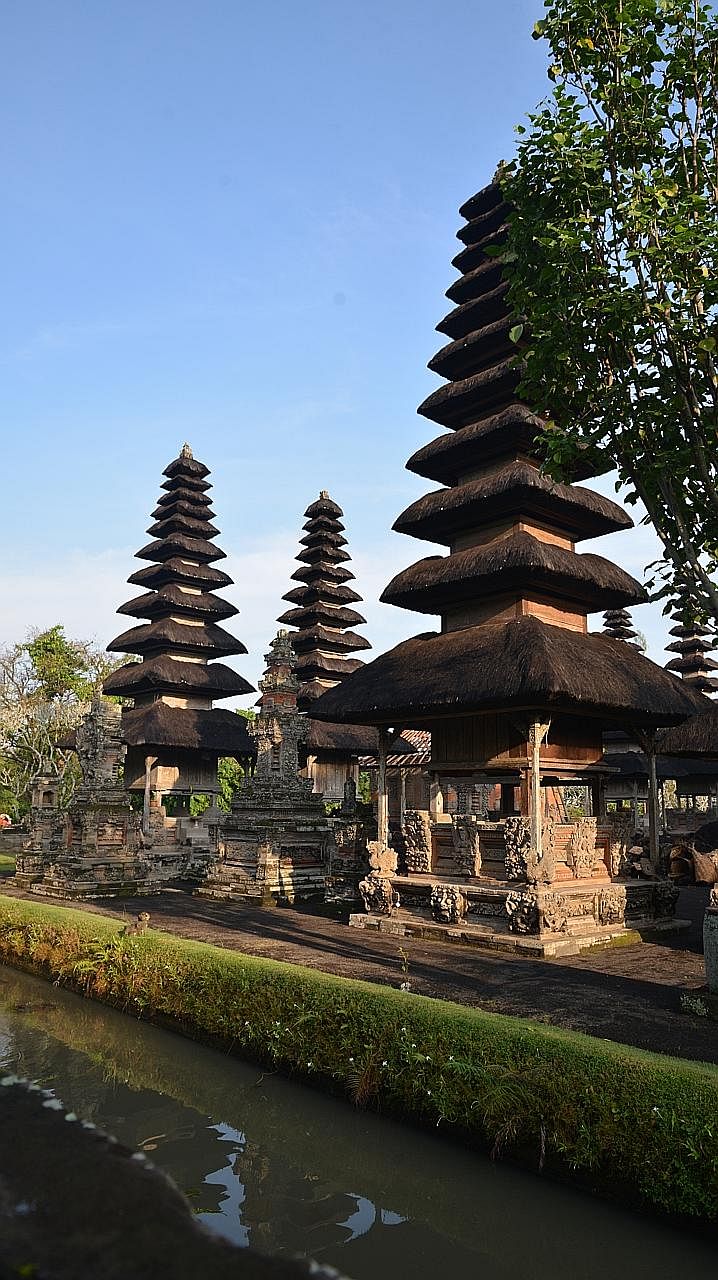Temple-hop to see a different side of Bali
Bali, famous for its beaches and rice terraces, is also known as the island of a thousand temples


Travellers in Bali often seek its iridescent green rice terraces and beaches, but there is another way to explore the island: templehopping.
Bali is home to thousands of Hindu temples with charming courtyards and intricate designs. More than 80 per cent of the locals are Hindu.
For the curious traveller, templehopping can be a delightful eyeopener. After all, each temple or pura has its own architecture, inspiring views and backstory.
Every neighbourhood has at least one temple. There are also temples for communities such as villages, clans and markets.
Islandwide, nine of the temples are considered so important that they are deemed to belong to the whole island rather than a specific community.
On a five-day trip to Bali earlier this month, I visited seven temples, travelling in a chauffeured car. Several tour companies also offer temple tours.
Although not all of the temples I visited were the most important ones, each offered a distinctly different experience due to its location, design and surroundings.
Although each temple has some areas - such as certain courtyards and walkways - reserved for devotees, tourists are free to roam around the rest of the complex. There is much to see, learn and appreciate.
Admission to each temple ranges from 6,000 to 30,000 rupiah (60 Singapore cents to S$3).
To enter a temple, visitors should dress modestly as a sign of respect. Skimpy clothing, bare shoulders and shorts are not allowed.
Wearing a sarong and sash is also required at most temples. These are usually provided at the gates.
At the most famous temples, you can expect to encounter touts either asking you to buy a sarong and sash or asking to be your "guide".
You can choose not to buy the sarong and sash. But sometimes, the "guides" can be so persistent that it is almost impossible to enter temple grounds without hiring one.
My suggestion? Tip him only half of what he is asking.
When a "guide" at the famous Pura Besakih insisted I pay him 200,000 rupiah, I said I would give him only half of that. When he later asked for another 100,000 rupiah as a tip, I gave him only 50,000 rupiah. Both times, he accepted.
Thankfully, touts operate only at the best-known places of worship.
At other temples, you can enjoy their beauty, history and culture at leisure and go home with a whole new experience of Bali.
Have a look at some of the temples in Bali at http://str.sg/4cgh
1. PURA BESAKIH

The largest and most important place of worship in Bali, this complex of more than 20 temples is often referred to as the "Mother Temple".
Located almost 1,000m up the side of Mount Agung, it is said to have been founded in the 8th century by a Javanese sage.
Today, it has hundreds of shrines for ancestral spirits, deified kings and nature gods.
As holy as this temple is, my experience was ruined by the "guides" who insist that tourists hire them.
Their initial request was 200,000 rupiah (S$20). Although I managed to bargain this down to half the amount, it was still not worthwhile as the "guide" was no more insightful than my guidebook.
Going with your own guide is pointless. It seems there is a cartel operating at the temple and it will insist you hire an "official guide".
Given the temple's beauty and historical significance, I would still have visited the site.
2. PURA TAMAN AYUN

Vast and imposing, its name means "beautiful garden" and the description is apt.
Surrounded by a wide, elegant moat, this temple symbolises the mythological home of the gods floating in the cosmic ocean.
The temple is thought to ensure the harmonious circulation of water from the mountains to the rice fields, the sea and back to the mountains.
Inside the moat are many towers, some of which honour Bali's holiest mountains - Batur, Agung and Batukaru.
The complex was the former state temple of Mengwi, an ancient kingdom comprising parts of the present-day districts of Badung, Tabanan and Gianyar. Unesco has named it a World Heritage Site.
3. PURA ULUN DANU BATUR

The second most important temple on Bali, it is located on Mount Batur, an active volcano which last erupted in 2000.
It is dedicated to the goddess of Lake Batur, a crater lake in the caldera of the volcano, who is believed to control water for irrigation systems throughout Bali.
The complex of more than 100 shrines used to be nearer the lake, down in the caldera. But an eruption in 1926 prompted villagers to move it to its present site on the caldera's highest rim. The upside is that the temple now boasts stunning views of the lake below.
If there is a temple where you should turn on your "tout alert", this is it. Walking towards the temple, I was accosted by several strangers asking me to buy a sarong and sash. I declined.
4. PURA TANAH LOT

Located on a rocky islet off the south-west coast, this striking sea temple is easily the most visited and photographed in all of Bali.
At high tide, the beach connecting it to the mainland gets submerged and the temple is surrounded by crashing waves. But when evening comes and the tide is low, busloads of tourists arrive for that compulsory sunset selfie on the beach.
The place is so commercialised that you have to walk through a maze of souvenir shops just to reach the temple. Even on the beach, expect vendors.
The upside? You do not have to worry about finding food and drink - there are restaurants and cafes everywhere and even an ATM.
And the view at sunset is as lovely as the postcards make it out to be - simply breathtaking.
5. PURA LUHUR ULUWATU

Located on a cliff about 70m above the sea, this temple on the south-western tip of the islandhas dramatic views of waves crashing onto the rocks below.
While only worshippers can access the small inner temple on the jutting tip, tourists can walk along the cliff and enjoy the sea breeze and sweeping view.
At sunset, a traditional Balinese kecak or dance and music drama is performed daily, with actors enacting scenes from the Ramayana epic.
If you watch only one dance performance in Bali, this should be it. Actors playing fantastical roles such as a golden deer and monkey king are accompanied by a choir of singing and chanting men. Admission is 100,000 rupiah (S$10.20).
My only bugbears are the monkeys that make the temple their home. They snatch hats, sunglasses - anything, really. A friend was at the temple last year when a monkey ran off with his spectacles and a local had to make the animal return it. Then the man asked for a tip and my friend obliged.
6. PURA GOA LAWAH

This is Bali's own Bat Cave.
Located next to a cliff, this temple has a cave filled with the winged creatures.
From some locations on the grounds, the bats can be seen flying around in the cave. I have never seen so many bats during the day.
Devotees believe that a giant snake - the deity Naga Basuki - lives in the cave and feeds on the bats.
Legend has it that the cave leads all the way to Pura Besakih, about 19km away. But I do not think visitors will want to try this route.
7. PURA TIRTA EMPUL

Famous for its spring, which is also a river source, this temple is a favourite among locals and tourists.
Many come for a dip in its bathing pools - or just to splash their faces - as visitors believe its waters have curative properties. There are also fishes in the pools.
Discovered in the 10th century, the spring is believed to have been created by the Hindu god Indra, who pierced the earth to release a spring of pure and sacred water. A temple was then built around the spring.
You are welcome to take a dip or simply dangle your feet by the edge of the pool.
And although not many places of worship qualify as family attractions, this one does - children can be seen gleefully enjoying themselves as if they were at a water playground in Singapore.

GETTING THERE
Bali is two hours and 40 minutes from Singapore by plane. Several airlines fly there, including Singapore Airlines, Jetstar Asia and Tigerair.
I travelled on Tigerair and paid $267 for a two-way flight. In Bali, I travelled in a chauffeured car, which cost between $70 and $152 a day.
Join ST's Telegram channel and get the latest breaking news delivered to you.
A version of this article appeared in the print edition of The Sunday Times on August 28, 2016, with the headline Temple-hop to see a different side of Bali. Subscribe

